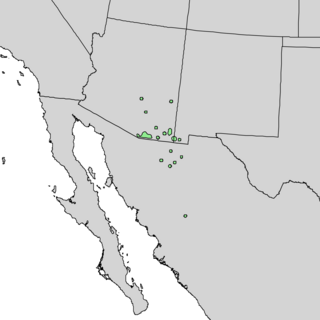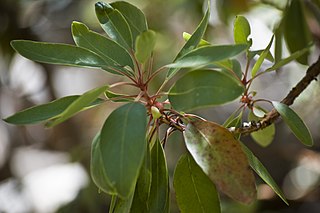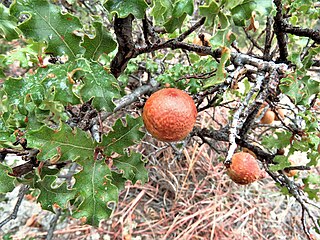
Juniperus californica, the California juniper, is a species of juniper native to southwestern North America.

The black-capped vireo is a small bird native to the United States and Mexico. It was listed as an endangered species in the United States in 1987. It is the only Vireo that is sexually dichromatic. Recovery of the species' population contributed to its delisting in 2018. The IUCN lists the species as "near threatened."

Parkinsonia florida, the blue palo verde, is a species of palo verde native to the Sonoran Deserts in the Southwestern United States and Northwestern Mexico. Its name means "green pole or stick" in Spanish, referring to the green trunk and branches, that perform photosynthesis.

Neltuma glandulosa, formerly Prosopis glandulosa, commonly known as honey mesquite, is a species of small to medium-sized, thorny shrub or tree in the legume family (Fabaceae).

Canotia holacantha, also known as crucifixion thorn or simply canotia, is a flowering shrub / small tree in the family Celastraceae.

Quercus toumeyi, the Toumey oak, is a North American species of tree in the beech family. It is found in northwestern Mexico and the southwestern United States. It grows in Sonora, Chihuahua, Arizona, New Mexico, and the extreme westernmost tip of Texas.

Bursera microphylla, known by the common name elephant tree in English or 'torote' in Spanish, is a tree in the genus Bursera. It grows into a distinctive sculptural form, with a thickened, water-storing or caudiciform trunk. It is found in the southwestern United States and northwestern Mexico.

Berberis nevinii, known by the common name Nevin's barberry, is a species of flowering shrub in the barberry family.

Arbutus arizonica, commonly known as Arizona madrone, is a tree species in the heath family that is native to the southwestern United States and northwestern Mexico. Its range extends along the Sierra Madre Occidental cordillera from the Madrean Sky Islands of southeastern Arizona and southwestern New Mexico south as far as Jalisco. It has been found in Sonora, Chihuahua, Durango, and Sinaloa, with one isolated population in Tamaulipas.

Quercus pungens, commonly known as the sandpaper oak or scrub oak, is a North American species evergreen or sub-evergreen shrub or small tree in the white oak group. There is one recognised variety, Quercus pungens var. vaseyana, the Vasey shin oak. Sandpaper oak hybridizes with gray oak in the Guadalupe Mountains of New Mexico and Texas.

Quercus grisea, commonly known as the gray oak, shin oak or scrub oak, is a North American species deciduous or evergreen shrub or medium-sized tree in the white oak group. It is native to the mountains of the southwestern United States and northern Mexico. It hybridises with four other oak species where the ranges overlap, the Arizona white oak (Q. arizonica), the Gambel oak (Q. gambelii), the Mohr oak (Q. mohriana) and the sandpaper oak (Q. pungens).

Quercus hypoleucoides, the silverleaf oak or the whiteleaf oak, is a North American species of oak tree or shrub. It grows in the southwestern United States and northern Mexico.

Pachycereus pecten-aboriginum is a columnar cactus plant native to Mexico. They can grow up to 15 m (49 ft) high. The trunk of this species is 1.2 to 5.0 m tall and the fruits are large and burr-like. The specific name, pecten-aboriginum, is from the Latin, and means "native combs". It was inspired by the use of the fruits as hair combs.

Erythrina flabelliformis, common name chilicote or western coral bean, is a plant species native to central and northwestern Mexico and the southwestern United States. It is known from Baja California as far south as Morelos and as far east as San Luis Potosí, as well as from Arizona and New Mexico.
Guardiola platyphylla, the Apache plant, is a North American species of plants in the family Asteraceae, native to Mexico and the southwestern United States. It is found in northwestern Mexico and the southwestern United States.
Bursera filicifolia is an uncommon North American species of trees in the Frankincense Family in the soapwood order. It has been found only in the States of Sonora and Baja California Sur in northwestern Mexico.
Bursera laxiflora is a North American species of trees in the frankincense family in the soapwood order, native to northwestern Mexico. It is fairly common in Sonora with additional populations in Sinaloa, Baja California Sur, and Socorro Island. There is a report of the species being found in the United States, but it is from the property of the Arizona-Sonora Desert Museum west of Tucson, most likely a cultivated or escaped specimen.
Bursera grandifolia is a Mexican species of trees in the frankincense family in the soapwood order. It is widespread across much of Mexico from Sonora to the Yucatán Peninsula, and found also in Central America as far south as Costa Rica.

Bursera hindsiana is a Mexican tree species in the frankincense family in the soapwood order. It grows in Sonora and in both of the states of Baja California. This includes several of the islands in the Gulf of California.

Bursera penicillata is a Mexican species of trees in the frankincense family in the soapwood order. It is widespread in much of Mexico from Sonora and Chihuahua to Oaxaca and Veracruz.




















